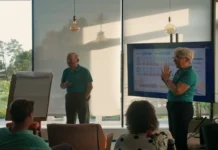
Researchers mapping the archaeological landscapes of the War of Independence and the Civil War have discovered an IRA dugout near Elton in county Limerick, the largest one found to date. The dugout, where the roof has since collapsed, was the Brigade HQ for East Limerick in 1921.
The discovery comes after community workshops were held around the area including in Knocklong, Kilfinane and Galbally earlier in 2023. Looking specifically at east Limerick, the Landscapes of Revolution Archaeology Project, led by UCD archaeologist Joanna Bruck, is attempting to make a record of sites that would have been used by the RIC, the IRA and other organisations during periods of conflict in the early 20th century.
Speaking with The Avondhu, Ms Bruck said the discovery of the dugout, which is on privately-owned land, was largely due to community involvement and information.
“We found that dugout near Elton through contact with the Kilfinane Coshlea Historical Society, but at the community workshops we would hear family stories say, if their grandfather was in the IRA, or maybe someone had told them the location of a safe house. Things like the Witness Statements from the Bureau of Military History help too”.
“It’s a generational thing; most of our informants are in their 80s and the next generation won’t necessarily know these things. The information is getting lost. And people are interested, but it can still be a sensitive area”.
Ms Bruck emphasises the importance of mapping such structures, as an emotional connection with history that is more dynamic than history learned from a textbook. That said, many of these physical remains are on private land, and connections and relationships must be built and privacy respected.
The Elton dugout is an area about seven metres long, excavated out of the centre of a ‘double ditch’ boundary. It had four bunks, an office and a cooking area; it regularly housed three Volunteers up until the Truce. The Brigade Adjutant gave an account of its construction thus:
‘an excavation was made to take a sectional wooden hut… carted to the site in sections… covered over with grass sods level with the surface of the rest of the bank. Access was by a trap-door, also sodded, and light was provided by a window hidden by a deep clump of briars. In its finished state it could not be detected visually by a stranger walking at the sides or even on top of the bank’.
If you have any information that may be useful to the project, contact Joanna at Joanna.bruck@ucd.ie









